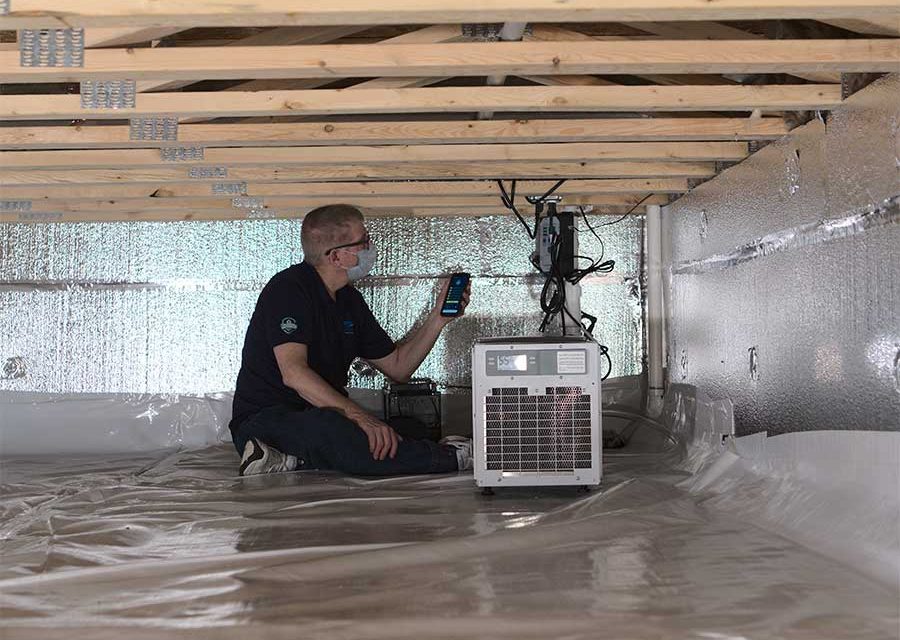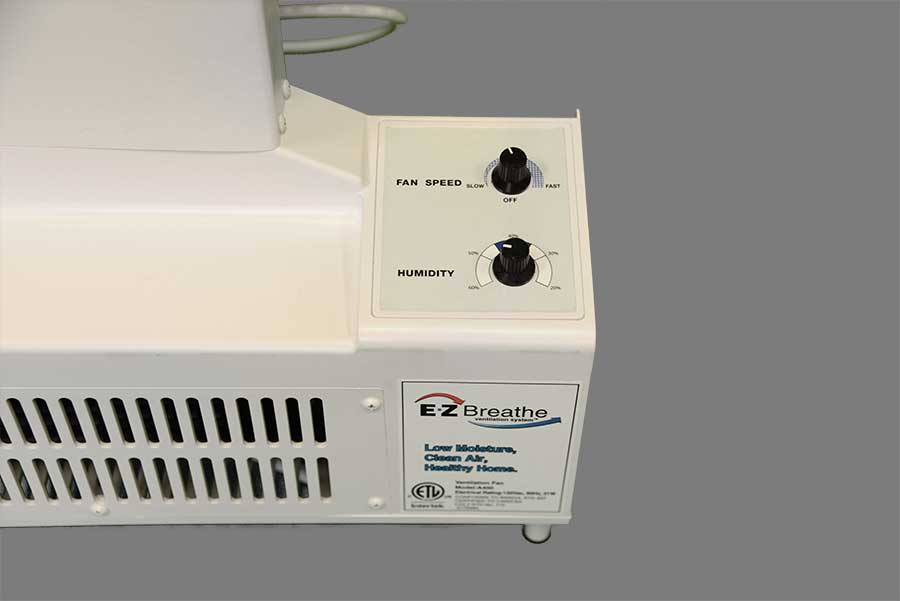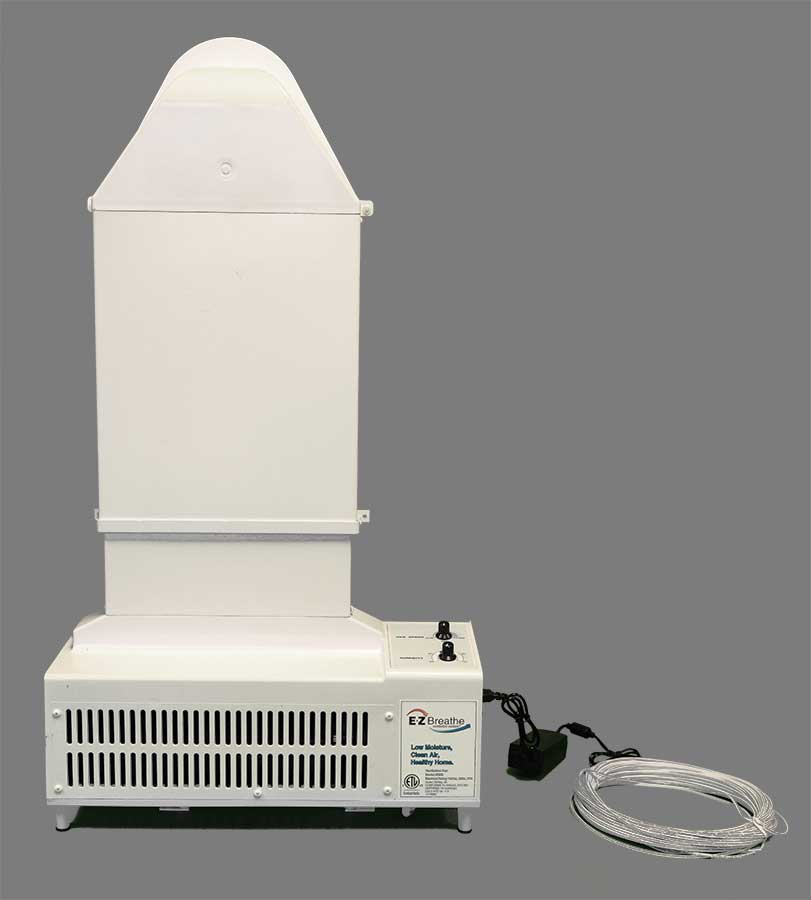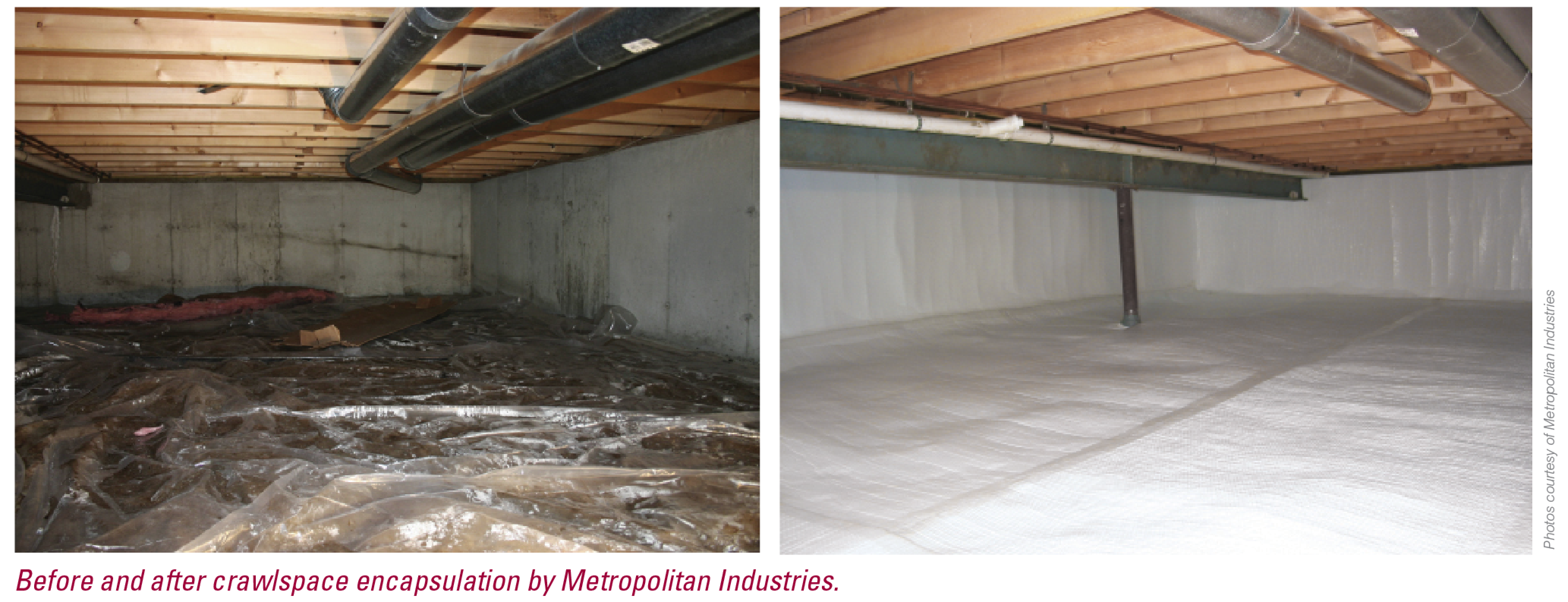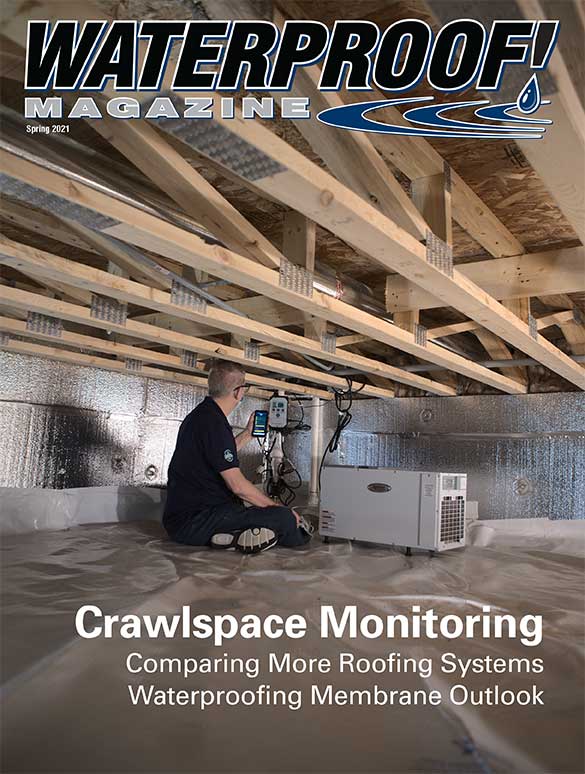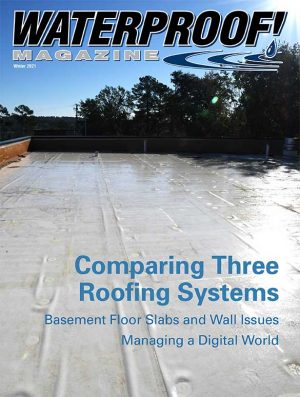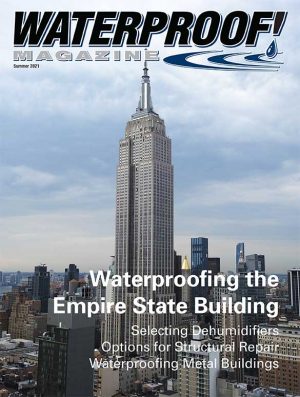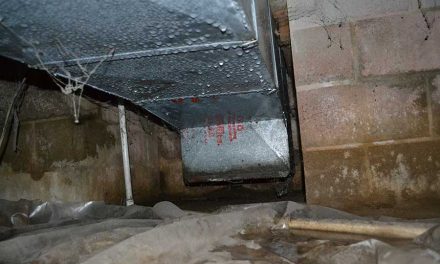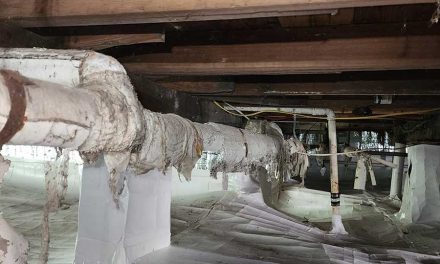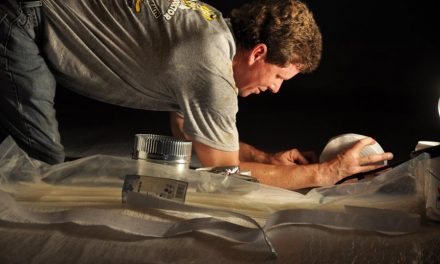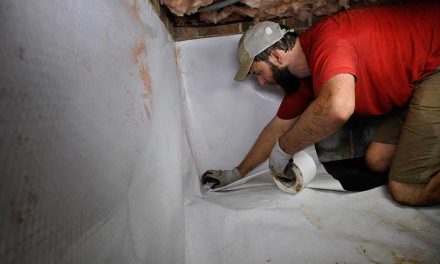By Vanessa Salvia
Basement Defender products used for the crawlspace encapsulation shown are SilverGlo wall liner on the walls and CleanSpace vapor liner on the top. Visible is a AGM 12V battery, an Aprilaire 1850 dehumidifier, and a Basement Defender Smart Device with temperature and humidity sensor, and 3-amp 12V DC battery charger. Not visible in the system is Delta MS membrane under the Cleanspace, and TerraBlock floor insulation under the Delta MS. Used in the system but not visible is a AC Zoeller N-98 sump pump and a DC Ultra III backup sump pump.
Monitoring what goes on in a crawlspace or basement is critical for a few reasons. Many people don’t regularly visit their basements, and may only go into the crawl space a few times a year. If there is a problem with the sump pump equipment, or the temperature and/or humidity level, it could result in catastrophic damage to your belongings. Even if you have a backup sump pump system, you are vulnerable, because components in the crawlspace or basement can fail. As Roy Spencer, inventor of the Basement Defender and owner of Chicago’s Perma-Seal Basement Systems, says, “All pumps fail. Motors, batteries, chargers and switches fail—it is not a matter of if, but when. Discharge lines get frozen or clogged and circuit breakers trip. Local alarms are of no use if you are not home to hear them, or you are not able to affect repairs right away.”
Take the recent accounts of the abnormally cold states of Texas, Louisiana, Mississippi, and Alabama as a case for monitoring. Having systems placed in these areas could have led to first-hand knowledge of whether pipes had burst. With sensors alerting of water in the crawlspace or basement, homeowners may have had an opportunity to shut the water off before that trickle became a full-scale frozen waterfall.
Building codes are increasingly recognizing that crawlspaces have a huge influence on indoor air quality, for good and bad. Rules in some states such as Oregon have recently changed to require that crawlspaces in all new construction be enclosed rather than simply vented. “40% of the air that we breathe inside our structure comes from either the basement or the crawl space,” says Erika Lacroix, president of EZ Breathe Ventilation Systems. “Open vents don’t work and they often create more problems in the crawlspace with issues of humidity, mold, and bacterias.”
The Importance of Monitoring
The more tightly our homes are enclosed, the more important it becomes to monitor air quality, radon, humidity, seepage problems, and plumbing leaks. Many times, homeowners don’t even realize they have a problem until they start doing some type of monitoring.
Ryan McCoy, marketing manager for ISI Building Products, urges homeowners to use crawlspace liners like ISI’s Viper CS or Viper CSX Crawl Space Vapor Barriers. Both are white, cross-woven extrusion-coated polyethylene membranes that prevent moisture ingress. McCoy says many times homeowners have the “out of sight, out of mind” mentality when it comes to their crawl space..They may not be connecting symptoms like poor indoor air quality, odors and draftiness with what is happening underneath the floor. When there’s a monitoring system in place, the contractor has data to work with, and the homeowner gets facts about what’s really going on.
“If you’ve done some monitoring ahead of the install, then you can show that what you’ve done is making a difference,” McCoy says. “Start with temperature and humidity monitoring, then do your remediation install, and then monitor afterwards to show the improvement.”
Installing a monitoring system also allows you to keep an eye out for potential problems after the project is complete. McCoy gives examples of a pipe bursting or someone doing work in the space and altering the original install. The homeowner can share their alerts with a relative, neighbor, or even a contractor—a big plus for snowbirds, vacationers, and property managers. For the contractor, monitoring can be an important source of recurring revenue in the form of a yearly maintenance fee or emergency repairs. “If you’re monitoring, you can identify those problems, whether you’re the homeowner or the contractor,” McCoy says. “With an alert-based system, you’ll be able to proactively identify issues.”
Monitoring vs. Testing
There are many systems and devices that monitor in different ways and alert homeowners, such as high water alarms, cellular or Wi-Fi devices that pair with apps on a cell phone, and email or text messaging alerts.
In the past, Spencer was dismayed to get calls from customers who had problems, even after installing the best pumps, batteries, and chargers available. He then developed the Basement Defender, a patented new system that doesn’t just monitor, but actually tests the pump systems each day. It’s a small panel that attaches to existing pumps and can be adapted to different models.
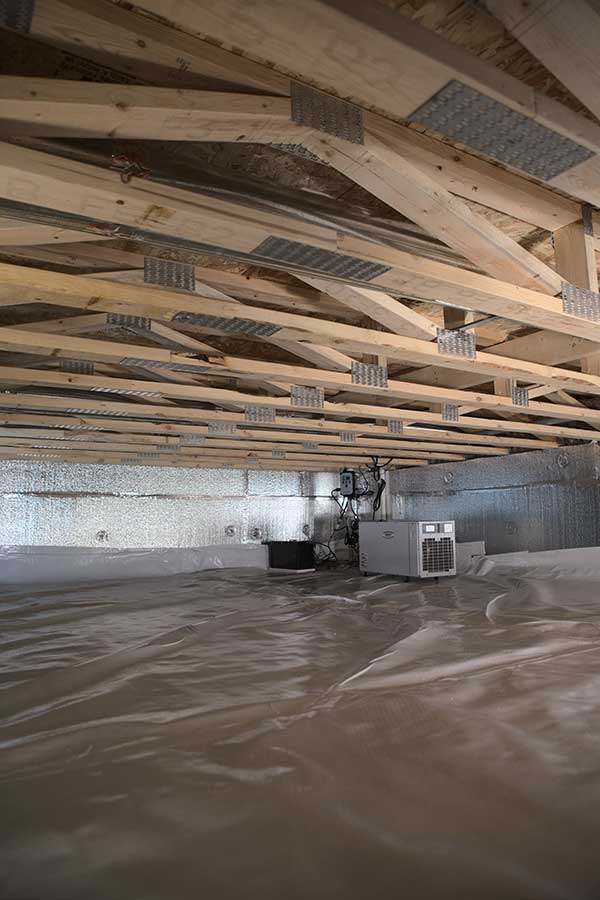
AGM 12V battery, an Aprilaire 1850 dehumidifier, and a Basement Defender Smart Device with temperature and humidity sensor.
The Basement Defender activates and tests up to two pumps daily, and provides updates via a mobile app and email. It activates the daily pump autotest and alert system, which exercises sump pumps and monitors the AC pump, float switches, electrical power, DC backup system, battery charger, Wi-Fi connection, temperature, and humidity. By registering for a plan, the homeowner can receive 12 months of free testing and alerts and can cancel the plan at any time. Spencer has set this system up as an opportunity for recurring revenue for installers after the free period ends.
“People don’t go down into their crawlspaces and check these things.” Spencer says. “It’s like having a service tech check on your basement and crawl space every day.”
Monitoring Air Quality
EZ Breathe has products for basements, crawlspaces, and attached garages. Homeowners and builders are increasingly aware that the home is a whole system of air exchange, not a series of separate spaces. Some form of mechanical ventilation is typically recommended because that keeps the air moving. Lacroix uses an analogy of air to water: “If water isn’t moving, it grows scummy,” she says. “The air in our homes is similar. When air doesn’t move it gets musty and bacteria starts to grow.”
What’s important to most people when it comes to a monitoring system is that it’s a “set it and forget it” system. “They don’t want to have to go down into the crawlspace and fiddle with settings or switch out filters,” she says. “Our system has no filters. It’s governed by a humidistat, so it will cycle on and off as needed. There’s no ongoing maintenance or monitoring that’s required.” The other important thing to customers is that the system works. Lacroix says use of their system has shown up to an 85% reduction in airborne particles. “People can feel the difference,” she says, “because it creates a healthier air environment in the whole home.”
Nikki Krueger, building science and business development manager for Therma-Stor in Madison, Wisconsin, which sells Santa Fe dehumidifiers, says there is a huge surge in interest across the country in both enclosing crawlspaces and monitoring and conditioning those spaces. She says that building homes on top of open crawlspaces was done in the past because it was fast and cost-effective, but the building science has caught up and now understands that air doesn’t move from one open vent straight across the crawlspace to a vent on the other side and go out.
“That’s not how thermodynamics works,” Krueger says. “Standards are now being updated to ensure healthier air quality by enclosing crawlspaces. But once that’s done, if you’re not monitoring, you’re guessing.”
Wade Sanders, sales manager of Therma-Stor’s pest control division, says both homeowners and the builders themselves are more knowledgeable about the importance of healthy crawlspace air than they have ever been before. “At any given time, there could be 7,000+ mold and fungal spores in a cubic yard of air in a crawlspace,” Sanders says. “That can lead to some pretty drastic health and structure considerations. By encapsulating and dehumidifying that crawlspace, you can almost eliminate that. And it turns the crawlspace into a space that is almost as livable as the livable space above it. It increases the value of the home and the home’s longevity.”
In 2020, the Environmental Protection Agency introduced a program called Indoor airPlus (www.epa.gov/indoorairplus). This is a voluntary addition to EnergyStar home standards in which the builder adheres to additional construction specifications that are related to indoor air quality. Indoor airPlus requires the selection and installation of:
- moisture control systems
- heating, ventilating, and air-conditioning systems
- combustion-venting systems
- radon resistant construction, and
- low-emitting building materials
Krueger says she spoke with a contractor who was seeking information about encapsulating crawlspaces because he was fielding warranty calls from homeowners with wooden floors buckling from moisture and paint peeling near the bottom of the home’s walls.
“Something has to justify the increased cost of encapsulating a crawl space and the subsequent monitoring of the environment,” Krueger says. “Someone might need to feel some pain before they install a dehumidifier, but once they understand what’s going on down there, installing a dehumidifier is just an obvious step.”
The Location of the Monitor
Where you place the monitor is important. A dehumidifier will either alert you or turn itself on based on what the sensor senses. It may seem obvious, but attach some hose to carry the dry air away from the dehumidifier to the farther outreaches of the crawlspace, which prevents the dehumidifier from creating a microclimate of dry air right around the dehumidifier. Locate the monitoring system away from the dehumidifier itself, and away from where the exhaust is coming out from the unit.
“Put the monitor in a location where, maybe, you’ve had some concerns before, or in a far reach of the crawlspace to really get a good understanding of what’s going on in that crawlspace overall,” says Kreuger. And Sanders recommends mounting the monitor as close to the subfloor as possible, and potentially on a floor joist, as water vapor rises.
Also, as both Krueger and Lacroix point out, just because a crawl space is encapsulated to code does not mean it will always stay within the acceptable parameters for relative humidity. Homeowners need to be educated on the healthy parameters of humidity levels within their crawl spaces and basements and how to evaluate that with monitors.
An Array of Notifications
Metropolitan Industries, in business in Illinois since 1957, started as a pump company in the wastewater business. Now, they offer complete control and monitoring solutions for commercial, industrial, and residential applications. Their Ion+ Connect is a cellular- and app-based monitor specifically for sump pumps. “The Ion+ Connect will send text messages to alert you if the pump has failed or switches fail, the temperature in the room, and it will allow you to monitor the pump,” says John Kochan Jr., president of Metropolitan Industries. “Let’s say you’re on vacation in Florida and there’s a problem. You can remotely run your pump and test it. It will show the current draw of the pump and the water level, temperature, and power. Through digital controls, you can set 14 parameters with audible and visual alerts that can alert both you as the homeowner and the contractor or plumber for faster service.”
Glentronics is a 31-year-old manufacturer of sump pumps. They have a large product line that is customizable with a mix-and-match selection of pumps, batteries, water alarms, and other accessories. CEO Alan Schulman’s invention team recently developed a patented device using In Touch 360 technology. The new device has water-detecting sensors on all four corners of a weighted, thin, rectangular sensor body. “With the new 360 sensor, whether it’s flat, upside down, or on any of its sides, those sensor pads are always in a position to catch the water, so it takes the guesswork out of positioning,” Schulman says. The In Touch 360 water sensor has a 20-foot wire with a plug incorporated that can be inserted into the Glentronics Pro Series water alarm. Additional sensors can be connected to each other for multiple location water monitoring.
Research Supports Monitoring
Whether your crawlspace is enclosed or not, actively monitoring may give you additional peace of mind and fewer surprises in the future. 2021 is the 40th anniversary of Advanced Energy, a nonprofit energy consulting firm that is primarily a research and training organization. Building science specialist Jonathan Coulter says they help take research and deploy it into the marketplace. Nearly 20 years ago the organization began studying crawlspaces. Coulter says crawlspace-related searches are often one of the top five most popular topics of all the services and topics that Advanced Energy has researched and posted on their website.
“We had colleagues that were finding more and more cross-vented crawl-spaces that were exhibiting moisture problems or contributing to mold and mildew,” Coulter says. “That was the impetus for our residential crawlspace research.”
Advanced Energy offers design elements and recommendations for crawlspaces based on federally funded research and unbiased third-party generated data. Visit www.advancedenergy.org/crawlspaces to find four pages of enclosed crawlspace recommendations. Coulter says the findings are useful because homeowners can provide these resources and have a conversation with the contractor before or during getting a bid, Likewise, contractors can use these resources
to justify the solutions they are suggesting.
Spring 2021 Back Issue
$4.95
Which Is a Better Roofing System: TPO, EPDM, or PVC? Part 2
Crawlspace Monitoring: The why, the how, and the differences
Waterproofing Membranes Outlook
AVAILABLE AS DIGITAL DOWNLOAD ONLY
Description
Description
Which Is a Better Roofing System: TPO, EPDM, or PVC? Part 2
By Joel Lozon
Don’t just leave the decision about roofing to your roofing contractor. This is the second part of our attempt to answer questions about roofing systems using TPO, EPDM, and PVC, and discern the basic differences between the three systems
Crawlspace Monitoring: The why, the how, and the differences
By Vanessa Salvia
Monitoring what goes on in a crawlspace or basement is critical for a few reasons. Many people don’t regularly visit their basements, and may only go into the crawl space a few times a year. If there is a problem with the sump pump equipment, or the temperature and/or humidity level, it could result in catastrophic damage to your belongings.
Waterproofing Membranes Outlook
By Global Market Insights
The global waterproofing membranes market size is anticipated to cross an astounding $14 billion USD by 2026, driven by the massive expansion of the infrastructure sector worldwide. Studies suggest that nearly 60% of all building damages and defects are caused due to water.
Additional Info
Additional information
| Magazine Format | Digital Download Magazine, Print Mailed Magazine |
|---|

